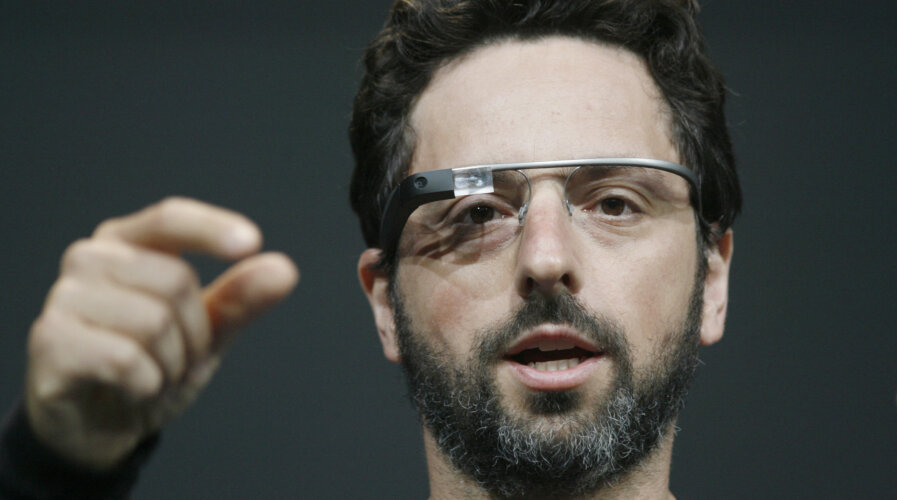
Sergey Brin, co-founder of Google appear at the keynote with the Google Glass to introduce the Google Class Explorer edition during Google’s annual developer conference, Google I/O, way back in June 2012 in San Francisco. AFP PHOTO/Kimihiro Hoshino (Photo by KIMIHIRO HOSHINO / AFP)
As Google pulls the plug on Google Glass, will other AR wearables suffer similar fate?
Remember the Google Glass? When it was first released nearly a decade ago, everyone thought the product would revolutionize how people work. Google Glass was viewed as the pinnacle of technology ahead of its time and created quite a frenzy when it was released.
Fast forward to now, Google Glass never achieved any greatness. In fact, the product was hardly popular, and eventually became just another accessory. For enterprise users, Google developed the Google Glass Enterprise Edition and made it available in 2017.
Described as a wearable device that helps businesses improve the quality of their output and help employees work smarter, faster and safer, the product soon found itself competing with other brands in the market as well. Not only were competitor brands cheaper, but most of them also offered more capabilities to users.
And now, Google has finally decided to pull the plug on Google Glasses. According to a statement by Google, they will no longer sell Glass Enterprise Edition and will only continue to support the product until September 15, 2023.
There could be many reasons why Google is doing this. Apart from plans to develop a newer version of augmented reality glasses, the competition in the industry is also high. When the glasses were first released, there were hardly any brands developing the product.
Google Glass is not the only one affected
Today, AR glasses are produced by a number of big tech companies, including social media giant Meta. Chinese tech companies have also been able to produce these glasses at a fraction of the price, which ends up increasing their sales.
In fact, according to a report by Counterpoint Research, mixed reality (XR) shipments in China crossed 1.1 million units in 2022. The report stated that virtual reality (VR) remains the dominant segment, contributing more than 95% to overall shipments.
As for brands, Pico is the number one brand with a shipment share of 43%, followed by DPVR at 36%. iQIYI, HTC and NOLO, each captured a single-digit share. The volume growth was produced by enterprise deals, mostly in the education and training sectors.
Meanwhile, while China saw increased shipments, IDC reported that global AR and VR headsets declined 20.9% year over year to just 8.8 million units. IDC believes the decline was not completely unexpected, however, given the limited number of vendors in the market, a challenging macroeconomic environment, and a lack of mass market adoption from consumers.
Meta dominated the overall market with nearly 80% share followed by Pico by ByteDance. However, consumer and business spending shifted away from AR and VR headsets as economies opened up leading to the decline in 2022. Meta even announced a huge price cut to its headset as demand is expected to slow down now.
“While Meta and ByteDance duke it out in the VR segment, Nreal has been able to slowly grow its presence by appealing to mobile gamers. Though it’s still early days for AR and VR, Meta has been able to build a moat for itself through its various first- and third-party content. This is where other players such as Sony and potentially Apple can provide meaningful competition though, in the long run, it’ll put pressure on others including ByteDance and Nreal,” said Jitesh Ubrani, research manager of Mobility and Consumer Device Trackers at IDC.
For Ramon T. Llamas, research director for Mobile Devices and AR/VR at IDC, “the release of the Meta Quest Pro last fall and the announcement of HTC’s XE Elite earlier this year demonstrate clear innovation as to what is possible for the ARVR market, and it should not be difficult to imagine others following suit. Moreover, commercial users with multiple use cases – ranging from on-boarding and orientation to training and collaboration – may gravitate to its appeal. However, given the still low penetration of AR and VR into the market, it may take several cycles for mixed reality headsets to gain salience.”
READ MORE
- Ethical AI: The renewed importance of safeguarding data and customer privacy in Generative AI applications
- How Japan balances AI-driven opportunities with cybersecurity needs
- Deploying SASE: Benchmarking your approach
- Insurance everywhere all at once: the digital transformation of the APAC insurance industry
- Google parent Alphabet eyes HubSpot: A potential acquisition shaping the future of CRM
